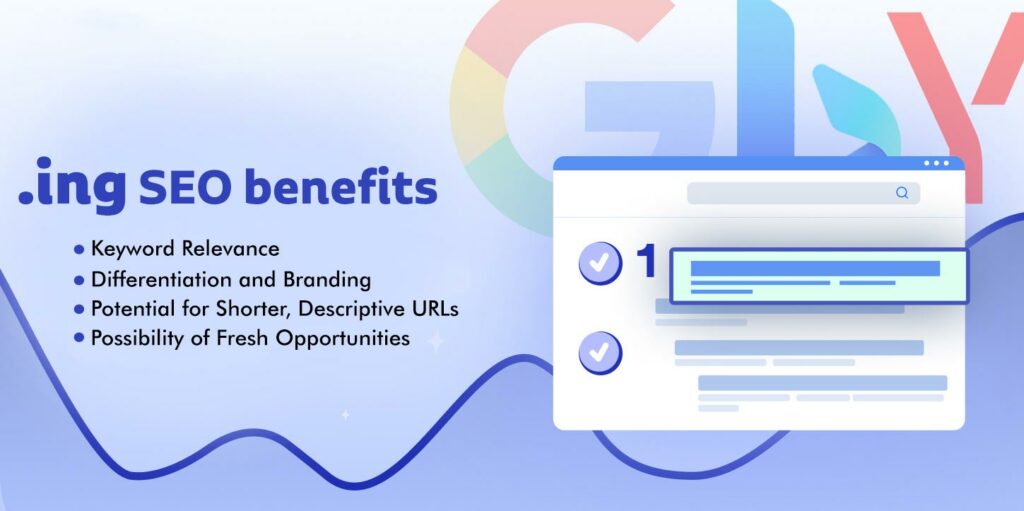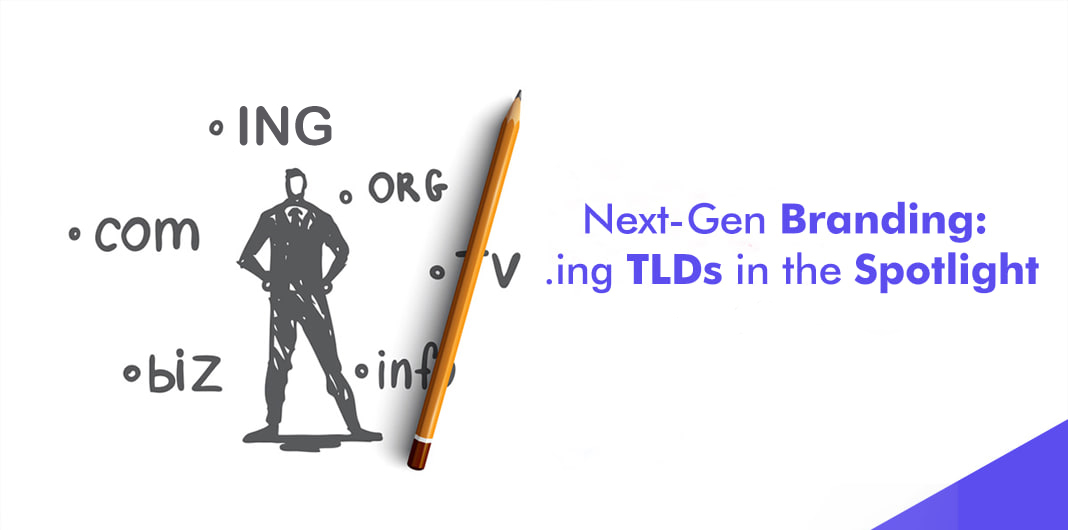Hey, everybody!
The new release of .ing top-level domains on the 5th of December created an opportunity to talk about branding and how important it is to have a memorable brand name. ( Read more in Google ).
We want to discuss the world of new possibilities for marketing that the internet has provided us with, and also, we will also take you through some essential details and information that can help your business or company grow in the rapidly changing world of online commerce. So let’s begin with Next-Gen Branding: dot ing TLDs in the Spotlight!

Why the names are so important?
The name and the brand are indeed what the buyer encounters first before seeing your product or even getting close to it. Many successful companies are willing to pay thousands or even millions of dollars to have a chance to get a hold of something that appeals to the everyday consumer
A famous example of that happened in 2010 when a company acquired the premium domain insurance.com for a mind-blowing sum of $35.6 million. They definitely wanted to ‘ensure’ this domain belongs to them.
Perhaps they know something more than we do?
Ever heard of companies like Google, Amazon, or Facebook? Those aren’t just a single name; they constitute the foundation of these companies’ identities.
They are known to us not only thanks to their advertising campaigns, although quite strongly because of them, but also, to a huge extent, thanks to their striking names and the associations they evoke in us.
Since childhood, we have all associated Coca-Cola with the New Year and the festive spirit, and Nike with strength, perseverance, and sports.

The Significance of Memorable Branding
The name Google comes from a mathematical term that denotes a very large number; at one time this name was quite new, sonorous, and even funny in some way.
Brands like Netflix, Tesla, and WordPress, on the other hand, not only have euphonious names but also directly refer to their industry.
This greatly helps them settle in the subconscious of people even if they have names that do not correspond to the products or services they provide.
While the name Apple seemingly had nothing to do with the products they were providing, thanks to a name as simple as a fruit, it remains among the top 5 most recognized brands in history and will likely retain that status for at least another hundred years.

What is SEO and the Benefits of Good Names
Search Engine Optimization (SEO), Is basically like giving your website a special makeup to make search engines like Google or Bing really like it.
In other words, the Internet is a giant library with billions of books in it, and SEO is a librarian that will help you find your book.
Don’t be mistaken, the role of a brand name is not limited to simple business identification, a good brand name can also help boost online visibility as well. Here’s how a smartly made brand name can lead to SEO success:
Keyword relevance: A brand name with relevant keywords contributes significantly to SEO. When users search for specific terms related to your brand or industry, having those keywords embedded in the brand name reinforces the relevance of your website to search engines.
User intent alignment: Your brand’s effective name reflects user intent. For example, if a brand in the fashion industry has a name like ‘TrendTrove,’ it will immediately show us the focus on trending fashion, going along with user search intent for current styles or trends.
Enhanced brand visibility: Associating your brand name with your targeted field is going to magically add to the visibility. This visibility not only attracts more traffic but also establishes the brand’s authority within its niche.
Natural link building: Brand names that incorporate keywords tend to attract natural backlinks. Other websites or blogs might naturally reference or link to a brand that embodies the keywords users are searching for, contributing positively to SEO.
Long-term SEO Strategy: The more you are consistent with the keywords in your brand’s name, the more it reinforces SEO effort in the long run. And with time passing and the brand getting more recognition, the association with the keywords is going to continue benefiting SEO performance.
When you create a name that uses industry-specific terms or goes together with user search queries, businesses can leverage the inherent SEO benefits of keyword relevance, contributing to improved search rankings and online visibility.
The Funny and Omnipresent Suffix ‘ing’
Now let’s touch on the topic of the English language, more specifically the ‘ing’ suffix. It definitely holds a unique place in the linguistics field, being the most enforcing, most actively leading, and truly the most alive suffix of all.
It is one of the most common forms of English verbs that we use a thousand times a day, be it while writing, speaking, or searching online.
Hell! I am writ(ing) this article, while you are read(ing) it and your wife is cook(ing) dinner, or possibly gossip(ing) about her colleagues.

That’s precisely why today is the day to talk about the new opportunities that have emerged!
With Google offering the ‘.ing’ domain as a top-level domain (TLD), it gains official recognition as a distinct online address. As a TLD, it joins the ranks of ‘.com,’ ‘.org,’ and others.
It can work with literally any given word, thanks to English grammar. Combining the ‘.ing’ suffix with nouns or adjectives results in domain names that express ongoing actions or experiences—’travel.ing,’ ‘blogg.ing,’ ‘shop.ing,’ and more. Your imagination is the limit. Many have already made attempts into jokes and humorism related to the release of the new TDL, but our team is trying to hold itself from it.
Let’s talk business!
Now, we will be frank here: most of the premium names for brands and businesses under .com, .org, and other popular TLDs are already taken. Because of that, people are forced to change their domains to less desirable ones, which sometimes leads to quite awkward choices.
But there’s a great chance for the readers of our blog, with the newly available TLD, just imagine what can be done! Imagine, you get to own domains like: uidesign.ing, webhost.ing, legalcounsel.ing, affiliatemarket.ing, etc.
You can also keep your eyes on domain auctioning websites to monitor and snag valuable .ing domains!

The benefits of .ing for SEO
As we have already pointed out the importance of choosing an appropriate domain name, it’s worth noting that the new TLD is going to provide additional specifications and opportunities to the keywords of the potential customers.
Thanks to the new ing TLDs, your URLs can now be much more descriptive, shorter, and more readable, generally enhancing the overall experience on your website.
Industries can highly benefit from the specificity of “ing’ domains. For example, teaching platforms can now use domains like teach.ing, learn.ing, or study.ing, immediately showing the focus of their business.
If we compare ‘ing in combination with a domain name, to the other less euphonious TLDs, such as..com, org, go, etc, it becomes obvious which one stands out and makes a more direct approach.
Last time, we mentioned how SEO is connected to domain names, and now let us see why ‘.ing’ is going to be a game changer in the field:
Keyword Relevance: In other words, an action-oriented keyword can inherently be part of .ing domains. For example, the domain“buy.ing” or “travel.ing” directly tells the reader what kind of content or services are provided and therefore adds on to the keywords’ relevance.
Memorability and User Engagement: Once a domain becomes memorable, it usually attracts more clicks and user engagement. Such intuitive .ing domains like learn.ing or cooking.ing will not only help with recall but also invite users to click because of its obviousness and readiness for action.
Differentiation and Branding: Unique domain extensions can make the website stand out in search results that are dominated by .com or .net domains. This distinction positively affects brand recognition and trust from users.
Potential for Shorter, Descriptive URLs: Also, shorter and descriptive URLs may be realized due to ‘.ing’ brevity as compared with other types of domains, which enhances readability, user experience, and search engine crawlability.
Possibility of Fresh Opportunities: Being one of the newest domain extensions available in the market, there may still be a number of desirable keyword-rich domains in the .ing domain space. This means that prime keywords may still be available, which you can purchase now.
Conclusion
We know choosing a wise brand name can be a game changer for all companies, and having a good ‘.ing’ TLD name can be worth a lot in the coming days. Some of the best domains are on sale for a few dollars and still not taken. If your desired domain is taken, you can also check different domain auctioning websites. You may find your domain in the sale for a few more bucks!
Disclaimer:
The information provided in this article is for general informational purposes only and should not be considered as professional advice. Readers are encouraged to consult with legal as some domains can include trademarks, financial, and domain industry professionals for personalized advice tailored to their specific situations. By accessing and using the information in this article, readers agree that they are doing so at their own risk and acknowledge the importance of due diligence in any domain-related transactions.
See you until the next time!





